The Absolute Best Way To Cook Steak on the Grill, According To Culinary Experts
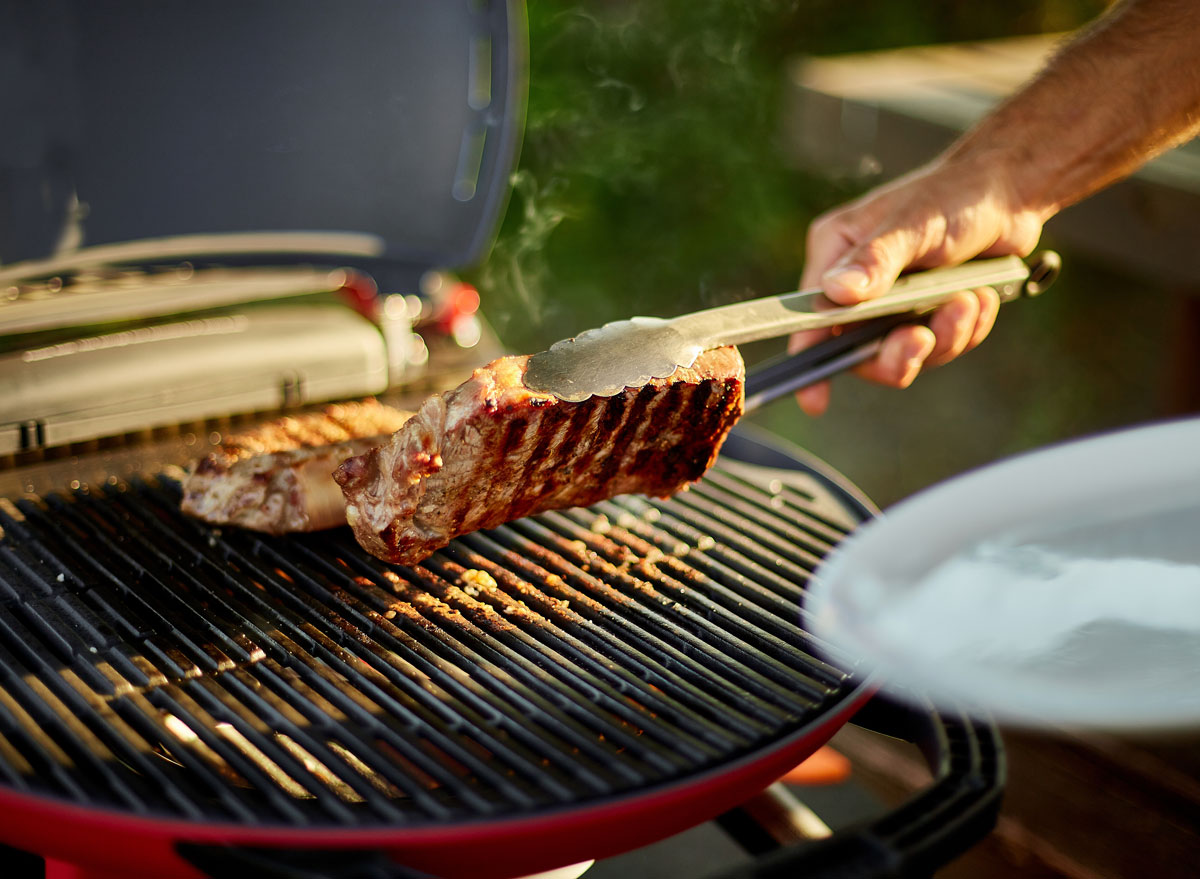
With spring in full swing and summer just around the corner, it’s time to plan that cookout, get outside—and get to grilling! While many foods can ignite your tastebuds after simmering over fiery flames, few can hold a candle to a classic juicy grilled steak. But for an apprehensive home cook or novice chef, the prospect of cooking steak on the grill may not only be confusing but also a little intimidating. So, how do you grill steak perfectly—and get it right every time?
To help us answer this question, we turned to two culinary experts with years of experience handling steaks of all varieties. Chef Michael Senich, executive chef and VP of culinary development at LongHorn Steakhouse, has 30+ years of experience as a pro-chef. Max Tucci is a culinary expert and author of the bestselling cookbook The Delmonico Way: Sublime Entertaining & Legendary Recipes From the Restaurant that Made New York! grew up in kitchens. He is also the grandson of culinary legend Oscar Tucci, the owner and operator of iconic restaurant Delmonico’s for the better part of the 20th century. (There’s even a cut of steak—the Delmonico steak—which is named after this fine-dining institution!)
Read on to find out the absolute best way to grill a steak that’s on par with the work of expert grill masters—and for more cooking tips to help you make the most of any leftover steak you may have after hosting your epic BBQ, be sure to check out The Absolute Best Ways To Reheat Steak So It Doesn’t Dry Out.
The best steps for grill prep
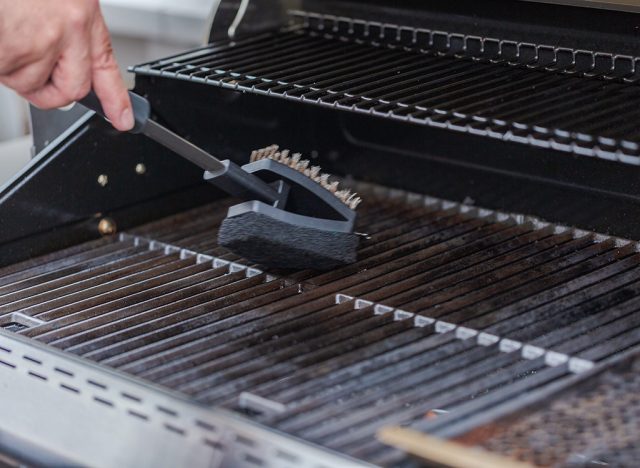
“Start with a clean hot grill, plenty of seasoning on the steaks, and a little patience. Some people get too anxious or nervous when grilling,” says Chef Senich.
Another critical prep step is to ensure you’re working with a quality cut of steak. “The quality of the meat you choose is crucial to achieving a perfect grilled steak,” says Tucci. “Look for well-marbled cuts with a good fat content, such as bone-in ribeye or sirloin.”Additionally, Tucci advises that you “make sure the steak is at room temperature before grilling.”
“Don’t be afraid of adding plenty of seasoning to the steak,” notes Chef Senich. “Quite a bit will fall off and stick to the grill during the cooking process.”
When cooking your steak, you will want to be sure your grill is set to high heat. “Preheat your grill to high heat before placing your steak on the grates,” says Tucci. “This will help create a nice sear on the outside of the steak while still keeping it juicy and tender on the inside.”
Tucci also has a tip to help you know when your grill is hot enough for you to start busting out your cuts of beef. “To test if the grill is hot enough, hold your hand about 5 inches above the grates and count to two,” he says. “If you have to pull your hand away, the grill is hot enough.” Though an effective practice, do proceed with caution to avoid getting burned.
Using a charcoal grill vs. propane
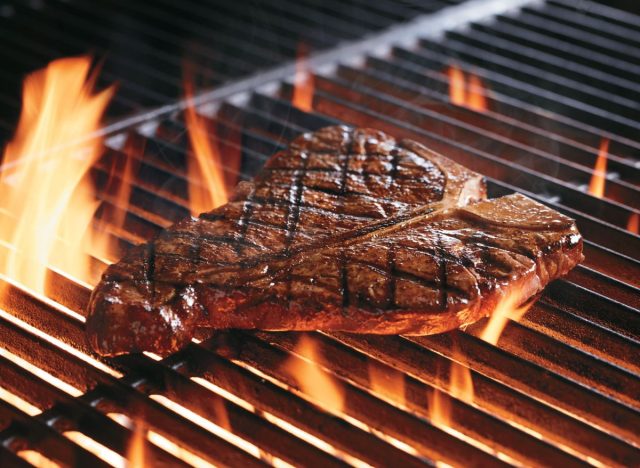
When you’re aiming to grill an absolutely perfect steak, which grill will yield the best results—a charcoal or propane grill?
“Both propane and charcoal grills can be used to grill a delicious and perfectly cooked steak,” says Tucci, adding that the decision on the type of grill to use as a home cook really comes down to personal preference—a sentiment that Chef Senich shares.
“I have both at my home and use them very differently,” says Chef Senich. “If I’m in need of a quick grilled meal, I use the propane grill as it heats up fast and is easy to shut down when finished. If I’m entertaining and the grilling is part of the show, I fire up the charcoal grill.”
“If your grilling is about convenience, precision, and even cooking, a propane grill may be the way to go,” explains Tucci. “If you prefer smoky flavor, high heat, and a pronounced char, I recommend a charcoal grill. (For me, it’s the better choice).”
Tucci notes that there are a few key differences between propane and charcoal grills, particularly in terms of how they may affect the outcome of your steak. Here are some of the advantages and disadvantages of each, according to Tucci and Chef Senich.
With a charcoal grill, you get:
- Flavor: “The charcoal will give you better flavor, especially with all the different flavored charcoals on the market,” says Chef Senich.
“Charcoal grills impart a smoky flavor to the meat that many people find irresistible,” adds Tucci. “The charcoal smoke can add a unique depth and complexity to the flavor of the steak.” - Heat: “Charcoal grills can get hotter than propane grills, which can help create a nice sear on the outside of the steak,” says Tucci.
- Char: “Charcoal grills tend to produce a more pronounced char on the outside of the steak, which can be desirable for some people but may not be for others,” says Tucci.
- More time and higher expenses: “Keep in mind it will take 20–30 minutes or longer to get those coals where they need to be,” explains Chef Senich. “Charcoal can also be more expensive to cook with versus propane, as well.”
With a propane grill, you get:
- Convenience: “Propane grills are easy to start and allow for precise temperature control,” says Tucci.
- Even cooking: “Propane grills typically distribute heat evenly, which can help ensure that your steak cooks evenly and stays juicy,” says Tucci.
- Flavor: “Propane grills don’t impart as much smoky flavor to the meat as charcoal grills do, but they can still produce a deliciously charred crust on the outside of the steak; a charred crust is one of my favorite things about a steak,” says Tucci.
What’s the best temperature to grill steaks?
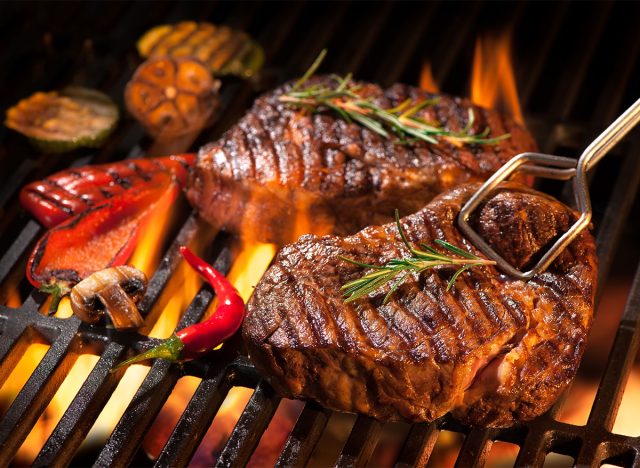
When it comes to the best temperature for grilling steak, Chef Senich claims that “550–650°F in the hot zone is ideal. You will achieve a great sear and beautiful grill marks,” he elaborates.
According to Tucci, there are a few key tenants of temperature control to follow while grilling a steak, based on insight gleaned from his father, restauranteur Mario Tucci, and a Delmonico’s grill master:
- Using high heat: “Grilling a steak at a high temperature helps to create a deliciously charred crust on the outside while still keeping the inside tender and juicy,” says Tucci. “Preheat your grill to around 450–500°F before placing the steak on the grates. This temp range is ideal for grilling thicker steaks.”
- Using medium-high heat: “If you prefer a slightly slower cooking time for your steak, you can grill it at medium-high heat, which is around 375–450°F,” advises Tucci. “This temp range is ideal for thinner steaks.”
- The two-zone grilling technique: “Two-zone grilling allows you to achieve a perfectly charred crust while still cooking the steak to your desired level of doneness without overcooking,” says Tucci. “A two-zone grilling involves creating two different temperature zones on the grill: one for high heat and one for medium-low heat. Start by searing the steak on the high heat zone for a few minutes on each side, then move it to the medium-low heat zone to finish cooking,” he explains. “This is a more advanced form of grilling, but once you get the hang of it, you will grill like [Delmonico’s grill master],” Tucci adds.
RELATED: 9 Secrets for Cooking the Best Steak That Only Chefs Know
How to grill steak to the perfect temperature.
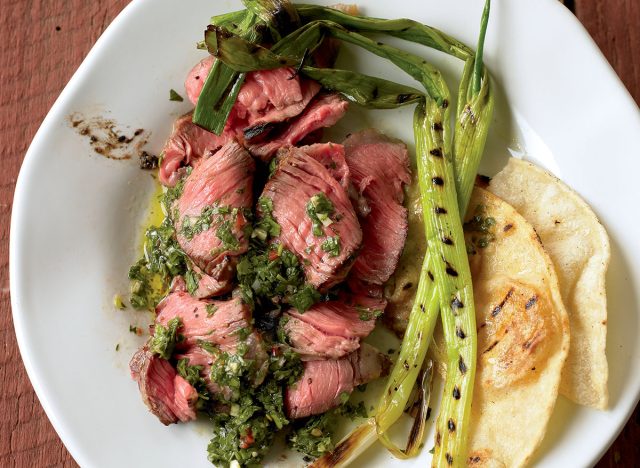
Whether you like your steak cooked rare, medium-rare, medium, or well-done, knowing the proper grilling technique will get you the perfect results every time.
- For a rare steak (120–130°F): “Preheat the grill to high heat,” says Tucci. “Season the steak with salt and pepper, and brush it with oil to prevent sticking. Place the steak on the grill and sear it for 2–3 minutes per side, flipping it only once to develop a crust. Use a meat thermometer to check the internal temperature of the steak.”
- For medium-rare (130–135°F): “Follow the same steps as for rare steak, but continue cooking the steak for an additional 1–2 minutes per side,” says Tucci. “Use a meat thermometer to check the internal temperature of the steak.”
- For medium (135–145°F): “Season and sear the steak as for rare and medium-rare, but continue cooking the steak for an additional 2–3 minutes per side,” explains Tucci. “Use a meat thermometer to check the internal temperature of the steak.
- For well-done: “Candidly, I do not have any advice for a well-done steak—it’s simply against The Delmonico Way standards,” says Tucci. “It was my father Mario Tucci, who instilled in me that a steak should never have a temperature of more than medium-rare. My family comes from Florence, Italy, where the famous Bistecca alla Fiorentina is served practically rare and purple in color; it would drive my father crazy if someone ordered a Delmonico steak well-done.”
That said, it takes different (steak) strokes for different folks. For those who prefer to eat steak that is a little more on the medium-well to well-done side, Chef Senich suggests that you “turn half of the grill to low or even off completely and move the steaks over to that section of the grill. This will bring the temperature of the meat up a little slower, and the results will be cooked through without being dry,” he explains.
How do you know when your steak is ready?
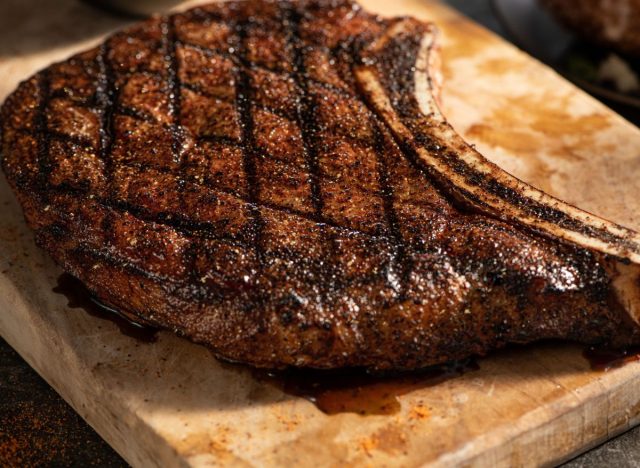
“An instant-read probe thermometer will make it easier to hit the exact doneness you’re looking for,” says Chef Senich, who claims this type of meat thermometer is “a must for any home cook. You will find it very useful when cooking just about anything that needs a precise temperature,” he adds.
“The more steaks you cook and touch when they are to your desired doneness, the less you become reliant on the thermometer,” explains Chef Senich. “Practice makes perfect—and you get to eat more steak!”
On letting your steak rest
“Letting a steak rest is important,” says Tucci. “First, it allows the juices to redistribute throughout the meat, making it more tender and flavorful. When meat is cooked, the heat causes the juices to move toward the center of the meat. Resting the steak allows those juices to move back toward the surface, resulting in a juicier and more evenly cooked steak. And secondly, resting the steak allows the temperature to even out, so that the steak is more uniformly warm when you cut into it.”
While you may have been told to let your steak rest for at least 10 minutes, Chef Senich suggests waiting only a couple of minutes.
“Typically, no more than one to two minutes is needed [to let your steak rest],” says Chef Senich. “Otherwise, your steak is going to get cold.”
When it comes to the overall steak grilling experience, Tucci leaves us with this sage advice: “Grill happy!” says Tucci. “Grilling is a fun experience; bring your best energy to the grill, and your results will be sublime steaks. It’s all about intentions when preparing any meal.”









